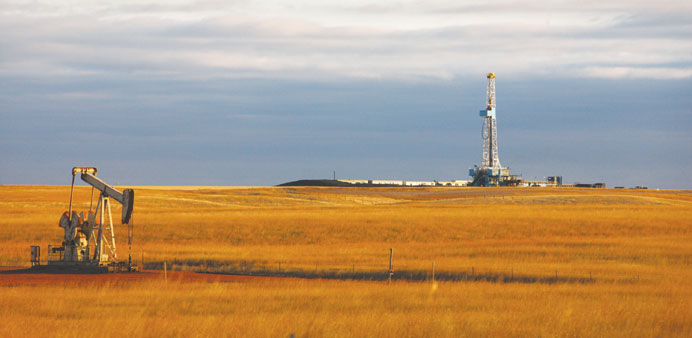An oil rig drills into the Bakken Formation in Western North Dakota, US (file). The Bakken formation, among the fastest-growing shale oil regions in the US, pumped 1.1mn bpd in February, according to data from the North Dakota Industrial Commission.
Bloomberg/London
Saudi Arabia boosted crude production to the highest in three decades in March, with a surge equal to half the daily output of the Bakken formation in North Dakota.
The kingdom boosted daily crude output by 658,800 barrels in March to an average of 10.294mn, according to data the country communicated to the Organisation of Petroleum Exporting Countries’ secretariat in Vienna. The Bakken formation, among the fastest-growing shale oil regions in the US, pumped 1.1mn bpd in February, according to data from the North Dakota Industrial Commission.
Oil prices have rallied about 16% in New York this month on stronger fuel demand and as a record decline in US rigs fanned speculation that the nation’s production will slow from its highest pace in three decades.
Prices collapsed almost 50% last year as Saudi Arabia led Opec in maintaining production in the face of a global glut rather than make way for booming US output.
“It confirms the new strategy of the Saudis,” Giovanni Staunovo, an analyst at UBS AG in Zurich, said by e-mail. “If Opec isn’t balancing the market any more, why should the Saudis hold so much spare capacity when they can use it to make money? Production is still likely to increase in the near term as domestic demand will increase.”
In the space of 31 days, Saudi Arabia managed a production boost that took drillers in North Dakota’s Bakken almost 3 years to achieve, according to data compiled by Bloomberg. Output from the Bakken shale increased by about 668,000 bpd from February 2012 to December 2014, according to data from the state’s industrial commission.
The increase reflects Saudi Arabia’s own growing requirements rather than an attempt to defend market share, according to Harry Tchilinguirian, head of commodity markets strategy at BNP Paribas in London.
“It’s a big jump in Saudi production but it is commensurate with the increase in their domestic needs,” Tchilinguirian said by e-mail. “Saudi Arabia has made large capacity additions in refining, and they’ll probably want to build up crude stocks before demand from local utilities peaks in the summer.”
The output figure for Saudi Arabia is in line with a level of 10.3mn a day announced by Oil Minister Ali al-Naimi in Riyadh on April 7.
Rising demand and weaker US output in the coming months will whittle away the global market’s surplus, Opec’s Vienna-based research department said.
“Higher global refinery runs, driven by increased seasonal demand, along with the improvement in refinery margins, are likely to increase demand,” Opec said. “Given expectations for lower US crude oil production in the second half of the year, these higher refinery needs will be partially met by crude oil stocks, reducing the current overhang in inventories.”
Opec’s data compiled from external sources showed an increase of about half the amount reported by Saudi Arabia, and lower output levels for the organisation as a whole. Saudi output rose by 346,800 bpd in March to 10.01mn a day, according to these figures, which Opec describes as being compiled from “secondary sources.”
Opec’s collective production increased by 811,800 bpd last month to 30.79mn a day as the Saudi boost was amplified by higher output from Iraq, the secondary sources show. Iraq restored production by 318,800 bpd to 3.63mn barrel.
Saudi minister al-Naimi reiterated on April 7 that Opec will only pare output to rebalance the global market if other producers share the burden. Al-Naimi has said several times since Opec’s November 27 decision that the group’s lower-cost supplies shouldn’t be curtailed to make room for higher-cost producers.
Opec reduced projections for supply growth from outside the group in 2015, by 165,000 bpd to 680,000 a day. Some of the reduction was concentrated in the US, where growth for 2015 is now estimated at 740,000 bpd compared with 820,000 a day in last month’s report. Quarterly growth in US supply in 2015 will peak in the second quarter and then slide for the rest of the year, it predicted.
As a result of these lowered expectations, Opec raised estimates for the amount of crude its members will need to provide this year. Opec’s 12 nations are required to pump an average of 29.3mn bpd in 2015, about 100,000 a day more than the group anticipated a month ago. That’s still about 1.5mn bpd less than the group produced in March.



